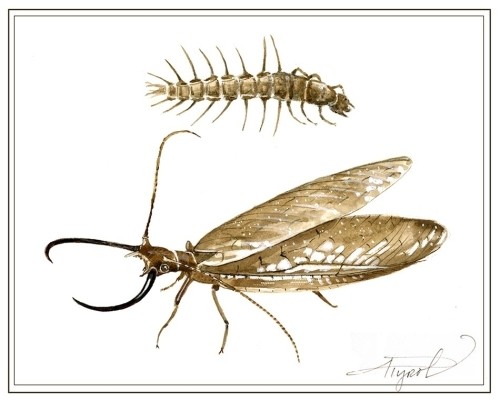
If freshwater insects did senior superlatives before graduating from aquatic life, what would yearbook entries say about dobsonflies? Largest? Most ferocious? Most likely to change names? Most likely to bite a human? Or to be used as fish bait? Or to be confused with a centipede?
All of these superlatives apply to larval hellgrammites – insects that, upon emerging from the water, promptly change names to become dobsonflies. These fascinating predators spend their larval stage eating other invertebrates, including other hellgrammites. They’re equipped with impressive mandibles that can open wider than the width of their own heads and can handily crunch through the tough exoskeletons of most insects. An occasional angler has learned the hard way that the mandibles of larger hellgrammites are quite capable of penetrating human skin.
Hellgrammites are important links in the food web between small invertebrates and fish. Six clawed legs, in addition to four hooks on prolegs at the back end, allow hellgrammites to forage over and under river rocks without being washed away. And they can be large. Topping out at 3.5 inches, hellgrammites are rivaled only by the giant water bugs for the title of largest aquatic insect on the block.
The paired lateral appendages on each abdominal segment may be the most intriguing features of these insects. At first glance they look like legs, which explains why my Saint Michael's College students sometimes think they’ve found some strange aquatic centipede. But these appendages are hauled along sticking out sideways and do not appear to help with locomotion.
So what are these structures? Voshell’s Guide to Common Freshwater Invertebrates of North America tells us they are gills. However, many hellgrammite species are well equipped with tufts of gill filaments that wave to circulate fresh water, while these lateral appendages do not appear to actively move. Researchers E.D. Neunzig and H.H. Baker, writing in 1991, suggested that the appendages are tactile, and that may well be the question addressed in a future experiment.
Adult male dobsonflies can reach 5.5 inches; roughly an inch and a half of that length is mandible. In late July and August, male dobsonflies account for most of my ‘alarming insect’ identifications at Saint Mike’s and on social media. The male’s mandibles look like paired sickles, though thankfully, they’re incapable of delivering a bite. The females, on the other hand, retain their biting function from the larval stage and should be treated with respect.
What are those enormous male mandibles for? Whenever traits differ between genders, it typically has something to do with sex. The extravagant peacock tail attracts peahens; large deer antlers intimidate other males or are used to fight rivals. It seems that the latter situation applies to dobsonflies. Thomas Simonsen and colleagues from the University of Alberta published photographs of male dobsonflies grappling and shoving with their mandibles. Eventually one managed to slide a mandible under his rival, and with a quick flip of the head, launched him off into the night. The one remaining male then devoted his attentions to a female and rested his mandibles across her wings. After some initial aggression, the female tolerated his attentions … but only to a point. She lost interest and he shuffled off rejected; no baby hellgrammites were made that evening, at least not by the couple being studied.
When mating is successful, female dobsonflies lay their eggs on trees near rivers and other water bodies. After eggs are laid, the female coats them with clear liquid that dries to a chalky white and protects the eggs from drying out. Hatchling larvae crawl, or simply drop, back into the water and the next generation begins. Hellgrammites may spend as long as five years before emerging to pupate and hatch into the adult form.

